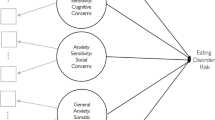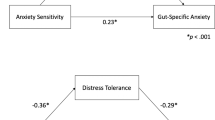Abstract
Research has shown that anxiety sensitivity (AS), or the fear of somatic arousal, predicts distress and maladaptive coping in a range of psychiatric conditions. More recently, the role of AS has been examined in pathological eating. In the current investigation, a two-study design was employed to examine the role of AS and eating expectancies in both self-reported and actual eating behavior. For Study 1, 42 overweight/obese participants completed questionnaires assessing AS, as well as eating behaviors and attitudes. In Study 2, 60 participants representing all weight ranges completed the same questionnaire battery and underwent a negative mood induction task followed by food exposure. Results of this study revealed a 3-way interaction between Anxiety Sensitivity Index-mental concerns subscale, Eating Expectancy Inventory—eating leads to feeling out of control subscale, and BMI suggesting that those elevated on all 3 constructs consumed the most calories. Results are discussed in relation to better understanding the role of AS and eating expectancy and its utility in identifying a subset of overweight/obese individuals at risk for maladaptive eating behavior.

Similar content being viewed by others
Notes
Analyses examining the interaction of BMI, AS-MC, and EEI Scale 3 were also examined while including change in PANAS positive and negative affect scales as covariates. Results indicate that while both variables did not emerge as significant predictors, the change in PANAS negative scale approached significance (β = .26; df = 7, 47; t = 1.93; p = .06). The 3-way interaction and AS-MC remained significant and follow-up analyses dividing the sample into normal and overweight/obese weight groups led to the same significant predictors as when changes in PANAS scores were not included as covariates. Despite no significant results in the model examining the interaction of BMI, AS-PC, and EEI Scale 1, these analyses were also examined including change in PANAS scales. Results indicate that all variables of interest including the 3-way interaction remained insignificant, and only the change in PANAS negative scale (β = .39; df = 7, 47; t = 2.80; p < .01.
References
Agras, W. S., & Telch, C. F. (1998). The effects of caloric deprivation and negative affect on binge eating in obese binge-eating disordered women. Behavior Therapy, 29, 491–503. doi:10.1016/S0005-7894(98)80045-2.
Anestis, M. D., Holm-Denoma, J. M., Gordon, K. H., Schmidt, N. B., & Joiner, T. E. (2008). The role of anxiety sensitivity in eating pathology. Cognitive Therapy and Research, 32, 370–385. doi:10.1007/s10608-006-9085-y.
Anestis, M. D., Selby, E. A., Fink, E. L., & Joiner, T. E. (2007). The multifaceted role of distress intolerance in dysregulated eating behaviors. International Journal of Eating Disorders, 40, 718–726.
Arnow, B., Kenardy, J., & Agras, W. S. (1995). The emotional eating scale: The development of a measure to assess coping with negative affect by eating. International Journal of Eating Disorders, 18, 79–90. doi:10.1002/1098-108X(199507)18:1<79:AIDEAT2260180109>3.0.CO;2-V.
Baumeister, R. F. (1990). Self-inference processes: The Ontario symposium, Vol. 6. Hillsdale, NJ, England: Lawrence Erlbaum Associates, Inc.; 1990. Anxiety and deconstruction: On escaping the self; pp. 259–291.
Carter, M. M., Miller, O., Sbrocco, T., Suchday, S., & Lewis, E. L. (1999). Factor structure of the anxiety sensitivity index among African American college students. Psychological Assessment, 11, 525–533.
Centers for Disease Control and Prevention. (2010). Prevalence of overweight, obesity, and extreme obesity among adults: United States, trends 1960–1962 through 2007–2008.
Cepeda-Benito, A., Gleaves, D. H., & Williams, T. L. (2000). The development and validation of the state and trait food-cravings questionnaires. Behavior Therapy, 31, 151–173. doi:10.1016/S0005-7894(00)80009-X.
Chua, J. L., Touyz, S., & Hill, A. J. (2004). Negative mood-induced overeating in obese binge eaters: An experimental study. International Journal of Obesity, 28, 606–610. doi:10.1038/sj.ijo.0802595.
Courbasson, C. M., Rizea, C., & Weiskopf, N. (2008). Emotional eating among individuals with concurrent eating and substance use disorders. Journal of Mental Health and Addiction, 6, 378–388. doi:10.1007/s11469-007-9135-z.
Craske, M. G., Roy-Byrne, P., Stein, M. B., Sullivan, G., Hazlett-Stevens, H., Bystritsky, A., et al. (2006). CBT intensity and outcome for panic disorder in a primary care setting. Behavior Therapy, 37, 112–119. doi:10.1016/j.beth.2005.05.003.
Davis, R., & Jamieson, J. (2005). Assessing the functional nature of binge eating in the eating disorders. Eating Behaviors, 6, 345–354. doi:10.1016/j.eatbeh.2005.02.001.
DeMartini, K. S., & Carey, K. B. (2011). The role of anxiety sensitivity and drinking motives in predicting alcohol use: A critical review. Clinical Psychology Review, 31, 169. doi:10.1016/j.cpr.2010.10.001.
Ehlers, A. (1995). A one-year prospective study of panic attacks: Clinical course and factors associated with maintenance. Journal of Abnormal Psychology, 104, 164–172.
Evers, C., de Ridder, T., & Adriaanse, M. (2009). Assessing yourself as an emotional eater: Mission impossible? Health Psychology, 28, 717–725. doi:10.1037/a0016700.
Flegal, K. M., Carroll, M. D., Ogden, C. L., & Johnson, C. L. (2002). Prevalence and trends in obesity among US adults, 1999–2000. Journal of the American Medical Association, 288, 1723–1727. doi:10.1001/jama.288.14.1723.
Fulton, J. J., Lavender, J. M., Tull, M. T., Klein, A. S., Muehlenkamp, J. J., & Gratz, K. L. (2012). The relationship between anxiety sensitivity and disordered eating: The mediating role of experiential avoidance. Eating Behaviors, 13, 166–169. doi:10.1016/j.eatbeh.2011.12.003.
Garner, D. M., Olmstead, M. P., & Polivy, J. (1983). Development and validation of a multidimensional eating disorder inventory for anorexia nervosa and bulimia. International Journal of Eating Disorders, 2, 15–34. doi:10.1002/1098-108X(198321)2:2<15:AID-EAT2260020203>3.0.CO;2-6.
Garner, D. M., Olmsted, M. P., Bohr, Y., & Garfinkel, P. E. (1982). The eating attitudes test: Psychometric features and clinical correlates. Psychological Medicine, 12, 871–878. doi:10.1017/S0033291700049163.
Grilo, C. M., Masheb, R. M., & Wilson, G. T. (2001). Subtyping binge eating disorder. Journal of Clinical and Consulting Psychology, 69, 1066–1072. doi:10.1037//0022-006X.69.6.1066.
Havermans, R. C., Giesen, J., Houben, K., & Jansen, A. (2011). Weight, gender, and snack appeal. Eating Behaviors, 12, 126–130. doi:10.1016/j.eatbeh.2011.01.010.
Hawkins, R. C., & Clement, P. F. (1984). Binge eating: Measurement problems and a conceptual model. In R. C. Hawkins, W. J. Fremouw, & P. F. Clement (Eds.), The binge purge syndrome: Diagnosis treatment, and research (pp. 229–251). New York: Springer.
Hayes, S. C., Strosahl, K. D., Wilson, K. G., Bissett, R. T., Pistorello, J., & Toarmino, D. (2004). Measuring experiential avoidance: A preliminary test of a working model. The Psychological Record, 54, 553–578.
Herman, C. P., & Polivy, J. (1984). A boundary model for the regulation of eating. In A. B. Stunkard & E. Stellar (Eds.), Eating and its disorders (pp. 141–156). New York: Raven Press.
Hetherington, M. M., Altemus, M., Nelson, M. L., Bernat, A. S., & Gold, P. W. (1994). Eating behavior in bulimia nervosa: Multiple meal analyses. The American Journal of Clinical Nutrition, 60, 864–873.
Hohlstein, L. A., Smith, G. T., & Atlas, J. G. (1998). An application of expectancy theory to eating disorders: Development and validation of eating and dieting expectancies. Psychological Assessment, 10, 49–58. doi:10.1037//1040-3590.10.1.49.
Hudson, J. I., Hiripi, E., Pope, H. G., & Kessler, R. C. (2007). The prevalence and correlates of eating disorders in the national comorbidity survey replication. Biological Psychiatry, 61, 348–358. doi:10.1016/j.biopsych.2006.03.040.
Jansen, A., Vanreyten, A., van Balveren, T., Roefs, A., & Nederkoorn, C. (2008). Negative affect and cue-induced overeating in non-eating disordered obesity. Appetite, 51, 556–562. doi:10.1016/j.appet.2008.04.009.
Johnson, K., Mullin, J. L., Marshall, E. C., Bonn-Miller, M. O., & Zvolensky, M. (2010). Exploring the meditational role of coping motives for marijuana use in terms of the relationship between anxiety sensitivity and marijuana dependence. The American Journal on Addictions, 19, 277–282.
Kaye, W. H., Gwirtsman, H. E., George, D. T., Weiss, S. R., & Jimerson, D. C. (1986). Relationship of mood alterations to bingeing behaviour in bulimia. British Journal of Psychiatry, 149, 479–485. doi:10.1192/bjp.149.4.479.
Lynch, W. C., Everingham, A., Dubitzky, J., Hartman, M., & Kasser, T. (2000). Does binge eating play a role in the self-regulation of moods? Integrative Physiological and Behavioral Science, 35, 298–313. doi:10.1007/BF02688792.
McHugh, R. K., & Otto, M. W. (2011). Domain general and domain specific strategies for the assessment of distress intolerance. Psychology of Addictive Behaviors, 25, 745–749. doi:10.1037/a0025094.
McNally, R. J. (1996). Anxiety sensitivity is distinct from trait anxiety. In R. M. Rapee (Ed.), Current controversies in the anxiety disorders (pp. 214–227). New York: Guilford Press.
McNally, R. J. (2002). Anxiety sensitivity and panic disorder. Biological Psychiatry, 52, 938–946.
Otto, M. W., Pollack, M. H., Fava, M., Uccello, R., & Rosenbaum, J. F. (1995). Elevated anxiety sensitivity index scores in patients with major depression: Correlates and changes with antidepressant treatment. Journal of Anxiety Disorders, 9, 117–223. doi:10.1016/0887-6185(94)00035-2.
Peterson, R. A., & Reiss, S. (1992). Anxiety sensitivity index manual, revised. Worthington, OH: International Diagnostic Systems.
Peterson, R. A., & Reiss, S. (1993). Anxiety sensitivity index revised test manual. Worthington, OH: IDS Publishing.
Rapee, R., & Medoro, L. (1994). Fear of physical sensations and trait anxiety as mediators of the response to hyperventilation in nonclinical subjects. Journal of Abnormal Psychology, 4, 693–699. doi:10.1037//0021-843X.103.4.693.
Reiss, S., Peterson, R. A., Gursky, D. M., & McNally, R. J. (1986). Anxiety sensitivity, anxiety frequency and the prediction of fearfulness. Behavior Research and Therapy, 24, 1–8. doi:10.1016/0005-7967(86)90143-9.
Schmidt, N. B., & Joiner, T. E. (2002). Structure of the anxiety sensitivity index psychometrics and factor structure in a community sample. Journal of Anxiety Disorders, 16(1), 33–49. doi:10.1016/S0887-6185(01)00087-1.
Schmidt, N. B., Lerew, D. R., & Jackson, R. (1997). The role of anxiety sensitivity in the pathogenesis of panic: Prospective evaluation of spontaneous panic attacks during acute stress. Journal of Abnormal Psychology, 106, 355–364. doi:10.1037/h0090325.
Schmidt, N. B., Zvolensky, M. J., & Maner, J. K. (2006). Anxiety sensitivity: Prospective prediction of panic attacks and Axis I pathology. Journal of Psychiatric Research, 40, 691–699. doi:10.1016/j.jpsychires.2006.07.009.
Simmons, J. R., Smith, G. T., & Hill, K. K. (2001). Validation of eating and dieting expectancy measures in two adolescent samples. International Journal of Eating Disorders, 31(4), 461–473. doi:10.1002/eat.10034.
Simons, J. S., & Gaher, R. M. (2005). The distress tolerance scale: Development and validation of a self-report measure. Motivation and Emotion, 29, 83–102. doi:10.1007/s11031-005-7955-3.
Smits, J. A. J., Berry, A. C., Rosenfield, D., Powers, M. B., Behar, E., & Otto, M. W. (2008). Reducing anxiety sensitivity with exercise. Depression & Anxiety, 25, 689–699. doi:10.1002/da.20411.
Strong, D. R., Lejuez, C. W., Daughters, S., Marinello, M., Kahler, C. W., & Brown, R. A. (2003). The computerized mirror tracing task, version 1. Unpublished manual.
Taylor, S. (1995). Anxiety sensitivity: theoretical perspectives and recent findings. Behavior Research and Therapy, 33, 243–258.
Taylor, S., Koch, W.J., Woody, S., & McLean, P. (1996). Anxiety sensitivity and depression: how are they related? Journal of Abnormal Psychology, 105, 474–479.
Watson, D., Clark, L. A., & Tellegen, A. (1988). Development and validation of brief measures of positive and negative affect: The PANAS scales. Journal of Personality and Social Psychology, 54, 1063–1070. doi:10.1037//0022-3514.54.6.1063.
Zinbarg, R. E., & Barlow, D. H. (1996). Structure of anxiety and the anxiety disorders: A hierarchical model. Journal of Abnormal Psychology, 105, 181–193. doi:10.1037//0021-843X.105.2.181.
Zinbarg, R. E., Barlow, D. H., & Brown, T. A. (1997). Hierarchical structure and general factor saturation of the anxiety sensitivity index: Evidence and implications. Psychological Assessment, 9, 277–284. doi:10.1037//1040-3590.9.3.277.
Zvolensky, M. J., Feldner, M. T., Leen-Feldner, E., Bonn-Miller, M. O., McLeish, A. C., & Gregor, K. (2004). Evaluating the role of anxiety sensitivity in smoking outcomes expectancies among regular smokers. Cognitive Therapy and Research, 28, 473–486. doi:10.1023/B:COTR.0000045559.73958.89.
Zvolensky, M. J., Lejuez, C. W., Kahler, C. W., & Brown, R. A. (2003). Integrating an interoceptive exposure-based smoking cessation program into the cognitive-behavioral treatment of panic disorder: Theoretical relevance and case demonstration. Cognitive and Behavioral Practice, 10, 347–357. doi:10.1016/S1077-7229(03)80052-4.
Zvolensky, M. J., McNeil, D. W., Porter, C. A., & Stewart, S. H. (2001). Assessment of anxiety sensitivity in young American Indians and Alaska Natives. Behaviour Research and Therapy, 39, 477–493. doi:10.1016/S0005-7967(00)00010-3.
Author information
Authors and Affiliations
Corresponding author
Rights and permissions
About this article
Cite this article
Hearon, B.A., Utschig, A.C., Smits, J.A.J. et al. The Role of Anxiety Sensitivity and Eating Expectancy in Maladaptive Eating Behavior. Cogn Ther Res 37, 923–933 (2013). https://doi.org/10.1007/s10608-012-9491-2
Published:
Issue Date:
DOI: https://doi.org/10.1007/s10608-012-9491-2




